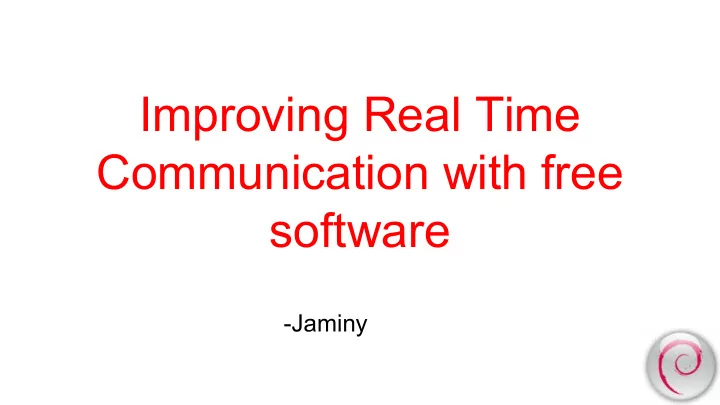

Improving Real Time Communication with free software -Jaminy
About me ● Blog: https://jaminycom.wordpress.com ● GitHUb: https://github.com/Jaminy ● IRC nick: Jaminy ● Debian Wiki: https://wiki.debian.org/SummerOfCode2016/StudentApplications/Jaminy
FOSSASIA-16 http://2016.fossasia.org/#speakers
GSoC-2016
What is Real Time Communication? ● Real Time Communication (RTC) is any mode of telecommunication in which users can exchange information instantly (in real time or live) or with very minor delay.
Examples of Real Time Communication ● Text messaging ● Video conferencing ● Calling
WebSockets - Heart of Real Time Communication between client and server ● WebSocket is a protocol providing full-duplex communication channels over a single TCP connection.
What is free software? ● “Free software” means software that respects users' freedom and community. ● Roughly, it means that the users have the freedom to run, copy, distribute, study, change and improve the software. Thus, “free software” is a matter of liberty, not price. To understand the concept, you should think of “free” as in “ free speech ,” not as in “free beer”.
What is freeRTC? ● Running your own, independent, federated and peer-to-peer RTC solutions, including instant messaging (IM), voice-over-IP (VoIP), video/webcam, social networking and WebRTC, using open standards and, in many cases, free, open source software.
Why ● Resilience: operating RTC servers to the same high standard as the rest of your non-stop infrastructure rather than relying on some vendor who provides a free download for anybody and everybody. ● Security: avoid installing proprietary, third party communications apps and plugins. ● Privacy: avoid letting sensitive information be harvested by cloud providers.
What is WebRTC? ● WebRTC is an open source project to enable real time communication of audio, video and data in Web and native apps.
Protocols ● SIP (Session Initiation Protocol) : Communications protocol for signalling and controlling multimedia communication sessions. ● XMPP (Extensible Messaging and Presence Protocol) : Communication protocol for message-oriented middleware based on XML (Extensible Markup Language) ● Peer to peer technology : Interconnected nodes share resources amongst each other without the central administrative system.
SIP vs XMPP ● Both SIP and XMPP can do all the same things. SIP can make phone calls, video calls and instant messaging (IM) sessions. XMPP can also make phone calls, video calls and IM sessions. There has been a tendency to use SIP more for voice and use XMPP more for IM
Voice and video over IP ● Voice over IP (VoIP) is a methodology and group of technologies for the delivery of voice communications and multimedia sessions over Internet Protocol (IP) networks, such as the Internet. ● One can make phone calls through internet by using VoIP phones and technology.
RTC available ● Skype ● Viber ● WhatsApp ● Snapchat These systems come with a big community of people though this Software is only free as free as in beer. Protocols and proprietary, privacy is basically non existent.
Free alternatives ● Jitsi ● Linphone ● Ekiga ● Tox(qtox), ● Mumble The communities are often small and due to a lack of servers, firewall traversal can be very cumbersome.
IoT and WebRTC
Goals 1. Helping people to avoid using proprietary communications tools like Skype, Viber and WhatsApp. 2. Simplifying the setup of free alternatives like Jitsi, Linphone, Ekiga, Tox (qtox), Mumble and their correspondent group and conference setups.
Would you like to list the sender, receiver and the date of the messages in each folder of your mail?
Do you have phone numbers and other contact details in old emails? Would you like a quick way to data-mine your inbox to find them and help migrate them to your address book?
E-mail mining ● Coding for connecting to an email account (using IMAP) and examines every message in every folder. ● Writing a basic Python script to look at the "To", "From" and "CC" headers of every email message in the folder. Identifying all the names and email addresses and writing them in a CSV file. ● Scanning the body of each message looking for phone numbers.(for messages in plain text format) ● Cleaning up the phone numbers and write them in international format and putting those in the CSV file too.
Challenges I faced ● New to Debian. ● Had to learn Python within two weeks.
Thank You!
Recommend
More recommend